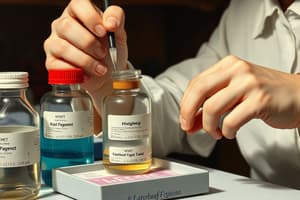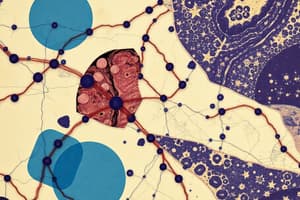Podcast
Questions and Answers
What are the goals of tissue fixation?
What are the goals of tissue fixation?
- Enhancing tissue coloration for better visual inspection.
- Facilitating the growth of microorganisms.
- Slowing down tissue metabolism and cellular activities.
- Preservation of tissue structure, prevention of decay, facilitating microscopic examination, preparation for molecular analysis, and archiving. (correct)
What are the characteristics of a good fixative?
What are the characteristics of a good fixative?
- Variable tissue penetration, variable reaction speed, moderate structural alterations, variable safety, variable cost.
- No tissue penetration, no reaction, no structural alterations, not applicable for use, no cost.
- Slow tissue penetration, delayed reaction, significant structural alterations, dangerous to use, high cost.
- Rapid tissue penetration, quick reaction, minimal structural alterations, safe to use, low cost. (correct)
Why is it important for a 10% formalin-buffered solution to have a pH range of 7.2 to 7.4 for tissue preservation?
Why is it important for a 10% formalin-buffered solution to have a pH range of 7.2 to 7.4 for tissue preservation?
- To ensure the stability of the fixative and effective tissue preservation. (correct)
- To improve tissue coloration.
- To accelerate tissue degradation.
- To make the solution less expensive.
What factors affect tissue fixation?
What factors affect tissue fixation?
What is the purpose of the dehydration process in tissue preparation?
What is the purpose of the dehydration process in tissue preparation?
What is the purpose of using intermediate fluids in tissue preparation?
What is the purpose of using intermediate fluids in tissue preparation?
Select the characteristic components of granulation tissue:
Select the characteristic components of granulation tissue:
Which change is typical of cell aging?
Which change is typical of cell aging?
What is characteristic of myocardial infarction from a pathological point of view?
What is characteristic of myocardial infarction from a pathological point of view?
What characterizes Lynch syndrome?
What characterizes Lynch syndrome?
Which of the following factors is NOT associated with the development of atherosclerosis?
Which of the following factors is NOT associated with the development of atherosclerosis?
Select the false statement regarding miRNA:
Select the false statement regarding miRNA:
Match the following programming languages with their primary usage:
Match the following programming languages with their primary usage:
Flashcards
Goals of tissue fixation
Goals of tissue fixation
To slow tissue metabolism, enhance coloration, preserve structure, and facilitate examination.
Characteristics of a good fixative
Characteristics of a good fixative
A good fixative has rapid penetration, quick reaction, minimal alteration, safety, and low cost.
Importance of 10% formalin pH
Importance of 10% formalin pH
Maintaining a pH of 7.2-7.4 ensures fixative stability and effective tissue preservation.
Factors affecting tissue fixation
Factors affecting tissue fixation
Signup and view all the flashcards
Purpose of dehydration in tissue preparation
Purpose of dehydration in tissue preparation
Signup and view all the flashcards
Use of intermediate fluids in preparation
Use of intermediate fluids in preparation
Signup and view all the flashcards
Components of granulation tissue
Components of granulation tissue
Signup and view all the flashcards
Cell aging change
Cell aging change
Signup and view all the flashcards
Pathological feature of myocardial infarction
Pathological feature of myocardial infarction
Signup and view all the flashcards
Characteristic of Lynch syndrome
Characteristic of Lynch syndrome
Signup and view all the flashcards
Atherosclerosis factor
Atherosclerosis factor
Signup and view all the flashcards
False statement about miRNA
False statement about miRNA
Signup and view all the flashcards
Cushing's ulcer cause
Cushing's ulcer cause
Signup and view all the flashcards
RDS morphological features
RDS morphological features
Signup and view all the flashcards
Cause of caseous necrosis
Cause of caseous necrosis
Signup and view all the flashcards
Cardiac muscle changes in emphysema
Cardiac muscle changes in emphysema
Signup and view all the flashcards
Characteristic of pancreatic necrosis
Characteristic of pancreatic necrosis
Signup and view all the flashcards
Example of steatosis
Example of steatosis
Signup and view all the flashcards
Primary skin cancer risk factor
Primary skin cancer risk factor
Signup and view all the flashcards
Causes of chronic inflammation
Causes of chronic inflammation
Signup and view all the flashcards
Cardinal signs of inflammation
Cardinal signs of inflammation
Signup and view all the flashcards
Phimosis condition
Phimosis condition
Signup and view all the flashcards
Hypospadias definition
Hypospadias definition
Signup and view all the flashcards
Epispadias definition
Epispadias definition
Signup and view all the flashcards
Impaired wound healing causes
Impaired wound healing causes
Signup and view all the flashcards
Most common death under 1 year
Most common death under 1 year
Signup and view all the flashcards
Study Notes
Tissue Fixation Goals
- Slowing down tissue metabolism and cellular activity
- Enhancing tissue coloration for better visual inspection
- Preserving tissue structure, preventing decay, enabling microscopic examination, and preparing for molecular analysis and archiving
Good Fixative Characteristics
- Rapid tissue penetration
- Quick reaction
- Minimal structure alteration
- Safe to use
- Low cost
Tissue Dehydration Purpose
- Replacing water with nonpolar substances
- Preserving tissue structure
- Enhancing tissue staining
Tissue Fixation Factors
- Time and temperature
- Material type (bone, soft tissue, cartilage)
- Chemical properties (pH) of the fixative
Studying That Suits You
Use AI to generate personalized quizzes and flashcards to suit your learning preferences.





